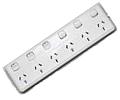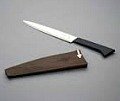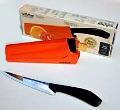Australian Inventions
At least one or both of these Australian inventions are in your home. Find out how Australians invented the power board and the self-sharpening knife.
Power Board
 In 1964, Frank Bannigan started a small appliance
shop in his garage on Kambrook Road,
in Melbourne, Australia.
In 1964, Frank Bannigan started a small appliance
shop in his garage on Kambrook Road,
in Melbourne, Australia.
Frank liked the name "Kambrook", so he called his business Kambrook Appliances. The company designed and manufactured small kitchen appliances.
Peter Talbot, an electrical engineer working for company, was frustrated at the lack of electrical sockets for testing appliances.
In 1972, Talbot designed a power board (also known as a a power strip or power bar ). It was a series of sockets on a board, bar or strip that plugged into an electrical socket.
The invention allowed for more than one appliance to be powered by a single electrical socket.
Bannigan liked the power board so much that he started manufacturing and selling them.
The invention was a huge global success, even though they never filed for a patent.
But eventually, the market was flooded with lots of competitors.
Sources: kambrook.com.au; creativecommons.org
StaySharp Knife
 Dennis Jackson was a product developer
for the Wiltshire Cultery Company in
Nuanwading, Victoria, Australia.
Dennis Jackson was a product developer
for the Wiltshire Cultery Company in
Nuanwading, Victoria, Australia.
In 1964 he came across the results of a consumer survey conducted in the United States. According to the survey, most respondents didn't know how to effectively sharpen a knife.
In fact, 80% of those surveyed didn't know how to properly sharpen a blade. More importantly, most preferred to have someone else sharpen their knives.
These findings inspired Jackson to invent a self-sharpening knife.
The problem with sharpening knives had much to do with the change in blade material. Instead of soft carbon steel, manufacturers were making blades from hard stainless steel, which is more difficult to keep sharp.
Jackson's idea was to make a scabbard that contained a spring loaded sharpening block. The sharpening block would engage the blade's cutting edge whenever the knife moved in and out of the scabbard.
After some prototypes were made, the company started doing market research.
They selected consumers in Melbourne to test the prototypes in their kitchens for a six month period and to report their experiences. The response from consumers was very positive.
 So, in 1969, a limited
production of a final
prototype was market tested
through
stores in
Perth, Australia to
further gauge consumer
response.
So, in 1969, a limited
production of a final
prototype was market tested
through
stores in
Perth, Australia to
further gauge consumer
response.
The sales from this test confirmed previous research that indicated consumers wanted the product.
In August, 1970 Staysharp was then released nationwide and throughout the world to great success.
Wiltshire compiled a patent portfolio and filed registrations in 35 countries for Staysharp as well as for improved versions of their invention including patents for self-sharpening scissors.
To date, Wiltshire has sold millions of Staysharp knives.
Sources: powerhousemuseum.com;wiltshire-online.com; creativecommons.org







